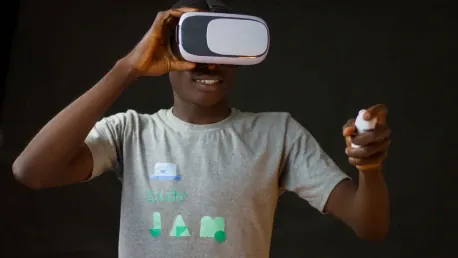In a world increasingly driven by technological shifts, the Augmented Reality (AR) and Virtual Reality (VR) market in the United States is poised for significant expansion. Fueled by rapid advancements in technology and a burgeoning consumer base eager for immersive experiences, the environment is ripe for innovation. Industry giants such as Samsung and WiMi Hologram Cloud are making strategic moves to seize emerging opportunities, setting the stage for a transformative era in digital experiences. As these companies advance their AR and VR initiatives, they influence the broader trajectory of the market’s growth and integration into various sectors.
Rapid Growth and Market Projections
The AR/VR market has witnessed a remarkable surge in recent years, spurred by continuous technological improvements and rising consumer interest. According to a report from Research And Markets, the U.S. AR/VR market, valued at $7.48 billion in 2023, is expected to grow to $12.4 billion by 2029. This projection, reflecting a compound annual growth rate (CAGR) of 8.63%, underscores the robust potential of these technologies. AR and VR are not just buzzwords; they are transforming sectors such as gaming, healthcare, retail, manufacturing, education, and real estate. These technologies enhance user experiences by creating immersive digital content that smoothly blends the physical and virtual worlds, paving the way for innovative applications and solutions.
The integration of next-generation technologies such as 5G, Artificial Intelligence (AI), and machine learning further catalyzes the adoption of AR and VR. These technologies enable faster and more reliable connectivity, smarter data processing, and more adaptive user interactions. As businesses across various industries recognize the value of AR and VR, there’s a rush to incorporate these tools into their operations. Whether it’s virtual shopping experiences that allow customers to “try before they buy” or advanced medical training simulations that provide a safer environment for learning, AR and VR are becoming indispensable. The combination of heightened consumer demand and continuous innovation ensures that the AR/VR market will continue to flourish.
Industry-Wide Adoption and Technological Integration
Adopting AR and VR technologies is reshaping how businesses and consumers interact with digital environments, signaling a profound shift across industries. Innovations in 5G connectivity, AI, and machine learning are driving the development of increasingly sophisticated and immersive experiences. These advancements facilitate the seamless integration of AR and VR into everyday applications, making these technologies an integral part of diverse sectors, from retail to education. The potential for virtual shopping experiences that mirror in-store visits, advanced medical training simulations, and interactive educational modules showcases the broad applicability and transformative power of AR and VR.
The AR/VR head-mounted device market is a critical area experiencing significant growth, further fueled by the rising interest in the metaverse. Data from IDC indicates a robust market recovery, with a projected 46.4% increase in shipments year-on-year by 2024, and a CAGR of 37.2% from 2023 to 2027. This surge in demand is driving ongoing advancements and attracting substantial investments in AR and VR technologies. Traditional manufacturers, tech giants, and startups are all drawn to the potential of AR and VR, recognizing the vast opportunities for innovation and market expansion. The convergence of these trends underscores the widespread and accelerating adoption of AR and VR, positioning these technologies at the forefront of digital evolution.
Samsung’s Strategic Moves in XR Technology
Samsung is making significant strides in the AR/VR landscape with its upcoming XR (extended reality) glasses, reflecting its strategic vision and commitment to innovation. Set to launch in the third quarter of 2025, Samsung aims to produce 500,000 units initially. The XR glasses will incorporate Qualcomm’s AR1 chipset, a decision likely influenced by factors such as product maturity, cost control, and market demand, despite Qualcomm introducing the more advanced AR2 chip in 2022. This strategic choice underscores Samsung’s careful market considerations and its commitment to offering cutting-edge technology while managing costs effectively. By leveraging existing market-ready technologies, Samsung positions itself to meet consumer needs and maintain competitive pricing, ensuring a successful entry into the XR market.
The upcoming XR glasses reflect Samsung’s dedication to balancing technological advancement with practical market strategies. Samsung’s approach to utilizing the AR1 chipset, despite the availability of the AR2, highlights a focus on product reliability and cost-effectiveness. This move indicates a keen awareness of market dynamics and consumer preferences, ensuring that the new XR glasses are both technologically advanced and economically viable. Samsung’s strategic decisions emphasize its role as a market leader, ready to offer innovative solutions that enhance user experiences while remaining accessible to a broad audience. As Samsung advances its XR technology, it sets a precedent for other players in the AR/VR space, reinforcing the importance of strategic innovation in expanding the market’s horizons.
WiMi Hologram Cloud’s Leadership and Innovation
WiMi Hologram Cloud Inc. has emerged as a leader in the AR sector, distinguishing itself through substantial expertise in AI wearable devices, VR, and AR technologies. WiMi’s strategic focus on AR technology leverages years of technical experience and extensive product research and development (R&D) to deliver high-quality AR/VR solutions. The company’s commitment to innovation and exploration of new strategic partnerships positions it for sustained growth and industry leadership. By continuously investing in R&D, WiMi aims to stay at the forefront of technological advancements, ensuring that its offerings remain cutting-edge and aligned with evolving market needs.
WiMi envisions users immersing in intelligent social environments that bridge historical and futuristic contexts, offering interactive experiences in historical and future societal developments. The company’s dedication to innovation is evident in its pursuit of new customer acquisitions and strategic partnerships. As WiMi expands its technological capabilities, it aligns with the stabilization and revival of the consumer electronics industry and the transformative potential of the AI-driven industry. WiMi’s proactive approach to exploring new opportunities and fostering innovation ensures that it remains a key player in the AR/VR market, driving forward the future of immersive technologies.
The Future of AR/VR Technologies
In a world increasingly driven by technological advancements, the Augmented Reality (AR) and Virtual Reality (VR) market in the United States is on the brink of substantial growth. This expansion is driven by rapid technological advancements and a growing number of consumers eager for immersive experiences. Industry leaders like Samsung and WiMi Hologram Cloud are strategically positioning themselves to capitalize on new opportunities, setting the stage for a transformative era in digital experiences. These companies’ advancements in AR and VR initiatives are not just reshaping their own futures but also influencing the broader market trajectory, pushing these technologies into various sectors such as gaming, education, healthcare, and retail. As more industries begin to adopt AR and VR, the market is expected to integrate deeply into everyday life, making these experiences more accessible and widespread. The potential for innovative applications is vast, signaling a promising future for AR and VR in the United States.









